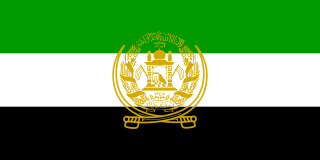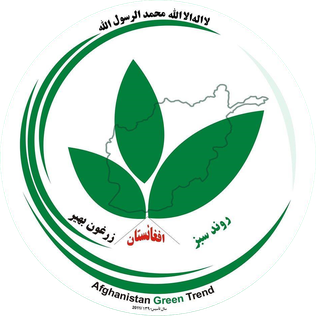Related Research Articles

Ahmad Shah Massoud was an Afghan military leader and politician. He was a guerrilla commander during the resistance against the Soviet occupation during the Soviet–Afghan War from 1979 to 1989. In the 1990s, he led the government's military wing against rival militia, and actively fought against the Taliban, from the time the regime rose to power in 1996, and until his assassination in 2001.

European influence in Afghanistan has been present in the country since the Victorian era, when the competing imperial powers of Britain and Russia contested for control over Afghanistan as part of the Great Game.

The history of Afghanistan includes the complete history of the modern-day nation of Afghanistan, from prehistory up to the establishment of the Emirate of Afghanistan in 1823 and to the present time. This history is largely shared with that of Central Asia, Persia, and the Indian subcontinent.

Gulbuddin Hekmatyar is an Afghan politician, and former mujahideen leader and drug trafficker. He is the founder and current leader of the Hezb-e-Islami Gulbuddin political party, so called after Mohammad Yunus Khalis split from Hezbi Islami in 1979 to found Hezb-i Islami Khalis. He twice served as prime minister during the 1990s.

The Durand Line, also known as the Afghanistan–Pakistan border, is a 2,640-kilometre (1,640 mi) international border between Afghanistan and Pakistan in South Asia. The western end runs to the border with Iran and the eastern end to the border with China.

The Panjshir Valley, also spelled Panjsher, is a valley in northeastern Afghanistan, 150 kilometres (93 mi) north of Kabul, near the Hindu Kush mountain range. It is divided by the Panjshir River. The valley is home to more than 100,000 people, including Afghanistan's largest concentration of ethnic Tajiks as of 1997. In April 2004, it became the heart of the new Panjshir Province, having previously been part of Parwan Province. Politically, this province has been considered the start point of Afghanistan's Jihad period against the Soviets. This province is also the birthplace of Afghanistan's national hero, Ahmad Shah Massoud.

The Northern Alliance, officially known as the United Islamic National Front for the Salvation of Afghanistan, was a military alliance of groups that operated between early 1992 and 2001 following the dissolution of the Soviet Union. At that time, many non-Pashtun Northerners originally with the Republic of Afghanistan led by Mohammad Najibullah became disaffected with Pashtun Khalqist Afghan Army officers holding control over non-Pashtun militias in the North. Defectors such as Rashid Dostum and Abdul Momim allied with Ahmad Shah Massoud and Ali Mazari forming the Northern Alliance. The alliance's capture of Mazar-i-Sharif and more importantly the supplies kept there crippled the Afghan military and began the end of Najibullah's government. Following the collapse of Najibullah's government the Alliance would fall with a Second Civil War breaking out however following the Islamic Emirate of Afghanistan's (Taliban) takeover of Kabul, The United Front was reassembled.

Haji Abdul Qadeer was an Afghan politician and prominent Northern Alliance leader who fought the Taliban during the Third Afghan Civil War. Originally a commander of the Hezb-i Islami Khalis faction during the Soviet–Afghan War, he then served as governor of Nangarhar Province, the head of the Eastern Afghanistan Shura, and later Vice President of Afghanistan and Minister of Public Works in the administration of Hamid Karzai from 19 June 2002 until his assassination on 6 July 2002. He was the older brother of fellow anti-Soviet and Northern Alliance commander Abdul Haq, who was assassinated in late 2001 by the Taliban.

Abdul Haq was an Afghan mujahideen commander who fought against the Soviet-backed People's Democratic Party of Afghanistan, the de facto Afghan government in the 1980s. He was killed by the Taliban in October 2001 while trying to create a popular uprising against the Taliban in Afghanistan in the wake of the September 11 attacks.
Gul Haider is a former mujahideen commander and official in the ministry of defense of Hamid Karzai's Afghan government.

The 1989–1992 Afghan Civil War, also known as the FirstAfghan Civil War, took place between the Soviet withdrawal from Afghanistan and the end of the Soviet–Afghan War on 15 February 1989 until 27 April 1992, ending the day after the proclamation of the Peshawar Accords proclaiming a new interim Afghan government which was supposed to start serving on 28 April 1992.

The 1992–1996 Afghan Civil War, also known as the Second Afghan Civil War, took place between 28 April 1992—the date a new interim Afghan government was supposed to replace the Republic of Afghanistan of President Mohammad Najibullah—and the Taliban's occupation of Kabul establishing the Islamic Emirate of Afghanistan on 27 September 1996.

The 1996–2001 Afghan Civil War, also known as the Third Afghan Civil War, took place between the Taliban's conquest of Kabul and their establishing of the Islamic Emirate of Afghanistan on 27 September 1996, and the US and UK invasion of Afghanistan on 7 October 2001: a period that was part of the Afghan Civil War that had started in 1989, and also part of the war in Afghanistan that had started in 1978.

Afghanistan–Pakistan relations refer to the bilateral ties between Afghanistan and Pakistan. In August 1947, the partition of British India led to the emergence of Pakistan along Afghanistan's eastern frontier, and the two countries have since had a strained relationship; Afghanistan was the sole country to vote against Pakistan's admission into the United Nations following the latter's independence. Territorial disputes along the widely known "Durand Line" and conflicting claims prevented the normalization of bilateral ties between the countries throughout the mid-20th century. Various Afghan government officials and Afghan nationalists have made irredentist claims to large swathes of Pakistan's territory in modern-day Khyber Pakhtunkhwa and Pakistani Balochistan, which complete the traditional homeland of "Pashtunistan" for the Pashtun people. Afghan territorial claims over Pashtun-majority areas that are in Pakistan were coupled with discontent over the permanency of the Durand Line which has long been considered the international border by every nation other than Afghanistan, and for which Afghanistan demanded a renegotiation, with the aim of having it shifted eastward to the Indus River. During the Taliban insurgency, the Taliban has received substantial financial and logistical backing from Pakistan, which remains a significant source of support. Nonetheless, Pakistan's support for the Taliban is not without risks, as it involves playing a precarious and delicate game. Further Afghanistan–Pakistan tensions have arisen concerning a variety of issues, including the Afghan conflict and Afghan refugees in Pakistan, water-sharing rights, and a continuously warming relationship between Afghanistan and India, but most of all the Taliban government in Afghanistan providing sanctuary and safe havens to Pakistani Taliban terrorists to attack Pakistani territory. Border tensions between Afghanistan and Pakistan have escalated to an unprecedented degree following recent instances of violence along the border. The Durand Line witnesses frequent occurrences of suicide bombings, airstrikes, or street battles on an almost daily basis. The Taliban-led Afghan government has also accused Pakistan of undermining relations between Afghanistan and China and creating discord between the neighbouring countries.

Baba Jan zahid, is a former senior security official of the Afghanistan government. He was a general of the Democratic Republic of Afghanistan, but during the collapse of Najib's government, he entered Kabul with Ahmad Shah Masoud's forces and served in various departments of the Islamic State of Afghanistan under the leadership of Ustad Burhanuddin Rabbani.

The Afghan conflict is a term that refers to the series of events that have kept Afghanistan in a near-continuous state of armed conflict since the 1970s. Early instability followed the collapse of the Kingdom of Afghanistan in the largely non-violent 1973 coup d'état, which deposed Afghan monarch Mohammad Zahir Shah in absentia, ending his 40-year-long reign. With the concurrent establishment of the Republic of Afghanistan, headed by Mohammad Daoud Khan, the country's relatively peaceful and stable period in modern history came to an end. However, all-out fighting did not erupt until after 1978, when the Saur Revolution violently overthrew Khan's government and established the Democratic Republic of Afghanistan. Subsequent unrest over the radical reforms that were being pushed by the then-ruling People's Democratic Party of Afghanistan (PDPA) led to unprecedented violence, prompting a large-scale pro-PDPA military intervention by the Soviet Union in 1979. In the ensuing Soviet–Afghan War, the anti-Soviet Afghan mujahideen received extensive support from Pakistan, the United States, and Saudi Arabia in a joint covert effort that was dubbed Operation Cyclone.

Pakistan's principal intelligence and covert action agency, Inter-Services Intelligence (ISI), has historically conducted a number of clandestine operations in its western neighbor, Afghanistan. ISI's covert support to militant jihadist insurgent groups in Afghanistan, the Pashtun-dominated former Federally Administered Tribal Areas, and Kashmir has earned it a wide reputation as the primary progenitor of many active South Asian jihadist groups.

The Islamabad Accord was a peace and power-sharing agreement signed on 7 March 1993 between the warring parties in the War in Afghanistan (1992–1996), one party being the Islamic State of Afghanistan and the other an alliance of militias led by Gulbuddin Hekmatyar. The Defense Minister of Afghanistan, Ahmad Shah Massoud, resigned his position in exchange for peace, as requested by Hekmatyar who saw Massoud as a personal rival. Hekmatyar took the long-offered position of prime minister. The agreement proved short-lived, however, as Gulbuddin Hekmatyar and his allies soon resumed the bombardment of Kabul.

The Basej-e Milli alternatively called Rawand-e Sabz-e Afghanistan was an Anti-Taliban Afghan nationalist Pro-Democracy political party in Afghanistan. It is currently active as an militant political movement actively engaged in the Republican insurgency in Afghanistan. It was founded by former Afghan intelligence chief Amrullah Saleh.
The following is an outline of the series of events that led up the War in Afghanistan (2001–2021).
References
- ↑ Marks, Peter (9 January 2011). "Play about Afghan conflicts gets encore performance with Pentagon blessing" . Retrieved 27 April 2018– via www.washingtonpost.com.
- ↑ "Designing the Great Game". www.hotreview.org. Retrieved 27 April 2018.
- ↑ Spencer, Charles (15 September 2010). "Blood and Gifts, National Theatre, review". The Daily Telegraph. London.
- ↑ Brantley, Ben (7 September 2010). "The Curtain Rises: Enter, Reality". New York Times. Retrieved 24 August 2012.
- ↑ Morgan, Abi (9 April 2009). "Abi Morgan: How I put the Taliban on stage". The Guardian. London.
- ↑ Higgins, Charlotte (1 April 2009). "England People Very Nice writer courts fresh controversy with Afghanistan play". The Guardian. London.
- ↑ Higgins, Charlotte (11 February 2009). "Theatre offers Afghanistan history lessons". The Guardian. London.
- ↑ "Archived copy". Archived from the original on 14 January 2011. Retrieved 10 January 2011.
{{cite web}}: CS1 maint: archived copy as title (link) - ↑ "The Great Game, Drama on 3 - BBC Radio 3". BBC. Retrieved 27 April 2018.
- ↑ Norton-Taylor, Richard (9 January 2011). "London theatre troupe to perform play on Afghan history for US military". The Guardian. London.
- ↑ Marks, Peter (9 January 2011). "'Great Game' gets encore, with Pentagon's applause". The Washington Post.